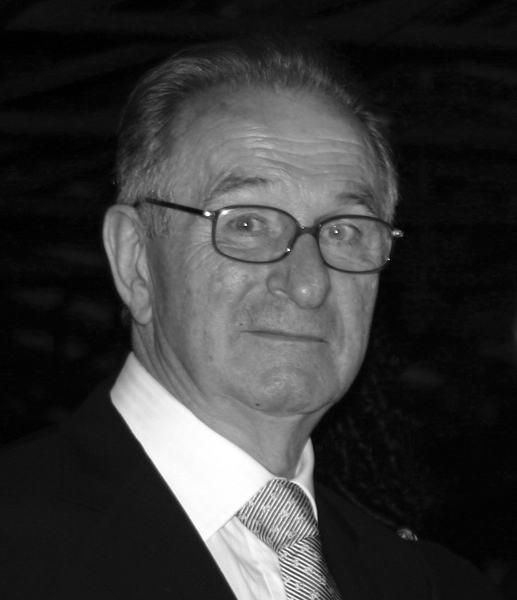Professor Emeritus Alan Davison, a fellow of the Royal Society who elevated the art of inorganic chemical synthesis in his laboratories at MIT for more than four decades, died Saturday, Nov. 14, at the age of 79 after a long illness.
Davison carried out his undergraduate studies in chemistry at the University of Swansea in Wales receiving a BS in 1959, followed by a PhD in 1962 in inorganic chemistry from Imperial College London under Nobel laureate Sir Geoffrey Wilkinson. Wilkinson was renowned for having pioneered inorganic chemistry and homogeneous transition metal catalysis.
After two years working as a chemistry instructor at Harvard University, Davison joined the Department of Chemistry at MIT in 1964 as an assistant professor in inorganic chemistry. By 1974, he had risen through the ranks of tenure to full professor.
“I first met Alan when he joined the MIT faculty where I was a second-year graduate student in Al Cotton's lab,” says Stephen Lippard, the Arthur Amos Noyes Professor of Chemistry. “He was a great source of practical knowledge, a man with a wonderful sense of humor, and a kind and patient mentor to me and many other graduate students. We maintained close contact over many decades, published together when I was at Columbia and then later at MIT, and remained friends for over five decades.”
Throughout his illustrious career, Davison made research contributions spanning organometallic, boron, coordination, and bioinorganic chemistries. He was a serial innovator whose numerous seminal discoveries in diverse areas provided starting points for generations of followers. “His contributions to synthetic inorganic and medicinal chemistry were legion,” Lippard adds. “He will be greatly missed.”
“Alan was part of my life starting in 1967 and was involved in providing me with the opportunity to come to MIT in 1975,” remarks Richard Schrock, the Frederick G. Keyes Professor of Chemistry. “He became my friend, colleague, and mentor.”
Davison will be immortalized for his work with octahedral homoleptic isocyanide complexes of technetium(I). In collaboration with the late Professor Alun G. Jones, professor of radiology at Harvard Medical School, he brought rational synthetic understanding of technetium chemistry to the field of nuclear medicine. Davison and Jones’ efforts included development of the first technetium-based myocardial perfusion-imaging agent, Cardiolite, an important tool in clinical nuclear cardiology.
"Alan Davison was an intuitive chemical genius who was gifted from an early age with magic hands in the laboratory," says Christopher Cummins, the Henry Dreyfus Professor of Chemistry. “He had a photographic memory, a sharp wit, and an unusually deep understanding of people combined with compulsive empathy. He was also an amazing storyteller. This set of traits is seldom combined in a single individual, but their coexistence in the person of Alan Davison explains why the many students for whom he served selflessly as unofficial mentor were so drawn to him and so valued his wisdom and insights."
Former graduate student Chris Orvig PhD ’81 remembers a particularly significant afternoon. It was the day he first met with Davison to be his teaching assistant, and Davison told him about his research project on the “new element” technetium. “I was hooked … for life,” Orvig says. “Alan’s breadth of knowledge in chemistry and his unselfish devotion to graduate students (both his own and those of other faculty) were legendary. He always had time to encourage and mentor — I was privileged to share a few years with him,” he says, adding, “I use the lessons of patience and understanding that I learned from him every day of my life.”
“Alan Davison's mentorship had a profound effect on his many students and postdocs,” says former Davison group member Mike Abrams PhD ’83. “His brilliance and chemical insight matched with humor and compassion were a precious gift to all of us.”
Throughout his illustrious career, Davison received many awards, including the Alfred P. Sloan Foundation Fellowship (1967); the Paul C. Aebersold Award for Outstanding Achievement in Basic Science Applied to Nuclear Medicine (1993); the Ernest H. Swift Lectureship at Caltech (1999); the American Chemical Society Award for Creative Invention (2006); the Carothers Award for outstanding contributions and advances in industrial applications of Chemistry (2006); the Jacob Heskel Gabbay Award in Biotechnology and Medicine (2006); and the Society of Nuclear Medicine's Georg Charles de Hevesy Nuclear Pioneer Award (2009).
Former graduate student Jim Kronauge PhD '87 noted: “As well as having been an intuitive and enlightening chemist, Alan was also extremely modest. He never lobbied for any of the major awards he received, and did not think he had done anything special to deserve them. Alan was most proud of the students’ teaching awards, and of course his admission to the Royal Society. Those accolades, he felt, were the most benevolent recognition by the people he loved.”
On June 17, 2005, at a party held in his honor, attended by his many colleagues and former students, Davison was presented with a 20” x 20” bronze plaque bearing a description of his remarkable career. The plaque is mounted outside his old office on the 4th floor of Building 6.
Alan Davison is survived by his wife of 21 years, Lynne Davison of North Falmouth, Massachusetts; his children, Jackie, Fiona, Robert, Erin, Myles, Rowena and Ian; 16 grandchildren, and three great-grandchildren.
In lieu of flowers, gifts may be made to the Alan Davison Fellowship Fund (#3296290) in his memory. Checks should be made payable to MIT and mailed to Liz McGrath, MIT Department of Chemistry, Room 18-388, 77 Mass. Ave., Cambridge, MA 02139.
Funeral services will take place on Saturday, Nov. 21, at 11 a.m. at Chapman, Cole and Gleason, 584 Route 28A, West Falmouth, Massachusetts.






